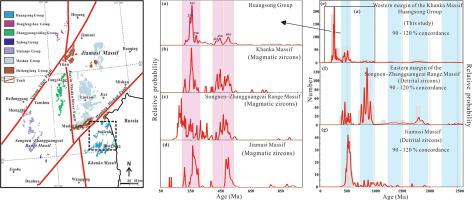Gondwana Research ( IF 7.2 ) Pub Date : 2021-07-07 , DOI: 10.1016/j.gr.2021.07.002 Siwen Zhang 1 , Feng Wang 1, 2 , Wenliang Xu 1, 2 , Fuhong Gao 1 , Jie Tang 1, 2

|
The Khanka Massif, as the easternmost micro-massif of the Central Asian Orogenic Belt, its tectonic attributes and Paleozoic tectonic evolution remain controversial. In this paper, we present detrital zircon U–Pb age data for sedimentary rocks from the Huangsong Group, in order to provide constraints in this regard. The Huangsong Group has previously been described as the Precambrian basement of the Khanka Massif, consists of slightly metamorphosed sedimentary rocks, and from bottom to top is divided into the Yangmu and Yanwangdian suites. Unexpectedly, the depositional ages of the Yangmu suite are (from bottom to top) 220–205 Ma, 249–239 Ma, and 509–485 Ma. The depositional ages of the Yanwangdian suite are (from bottom to top) 426–390 Ma and 232–220 Ma. Clearly, the rocks do not have a logical stratigraphic sequence and, therefore, we propose that the “Huangsong Group” represents a stack of tectonic terrains with diverse ages (early Paleozoic to early Mesozoic) rather than a continuous sedimentary sequence. The potential sediment sources were mainly a nearby magmatic arc and batholiths, because the zircons are euhedral–subhedral, exhibit well-developed oscillatory zoning, and have high Th/U ratios. The occurrence of Precambrian detrital zircon grains implies the existence of remnants of Precambrian basement along the western margin of the Khanka Massif in the early Paleozoic. A comparison of magmatism in the regional massifs revealed there was a tectonic affinity between the western margin of the Khanka Massif and eastern margin of the Songnen–Zhangguangcai Range Massif in the Paleozoic. Based on the detrital zircon age populations and trace element contents, we conclude that the western Khanka Massif experienced a change from a stable to an active margin setting during the late Paleozoic, which was caused by subduction of the Paleo-Asian oceanic lithosphere.
中文翻译:

中亚造山带最东端Khanka地块黄松构造地貌的构造历史:来自碎屑锆石U-Pb年代学的约束
汗卡地块作为中亚造山带最东端的微地块,其构造属性和古生代构造演化仍存在争议。在本文中,我们提供了黄松群沉积岩碎屑锆石 U-Pb 年龄数据,以提供这方面的限制。黄松群以前曾被描述为汗卡地块的前寒武纪基底,由微变质沉积岩组成,自下而上分为杨木组和炎王店组。出乎意料的是,杨木组的沉积时代(自下而上)分别为220~205 Ma、249~239 Ma、509~485 Ma。燕王店组的沉积时代为(自下而上)426~390 Ma和232~220 Ma。显然,这些岩石没有合乎逻辑的地层序列,因此,我们认为“黄松群”代表了一系列不同时代(早古生代到早中生代)的构造地形,而不是一个连续的沉积序列。潜在的沉积物来源主要是附近的岩浆弧和基岩,因为锆石是自形-半自形体,显示出发达的振荡分带,并且具有较高的 Th/U 比。前寒武纪碎屑锆石颗粒的出现暗示早古生代沿汗卡地块西缘存在前寒武纪基底残余。区域地块岩浆活动对比表明,古生代康卡地块西缘与松嫩-张广才岭东缘具有构造亲缘关系。根据碎屑锆石年龄群和微量元素含量,











































 京公网安备 11010802027423号
京公网安备 11010802027423号